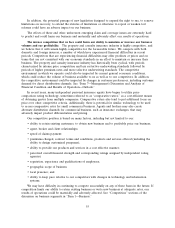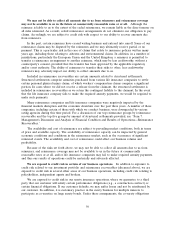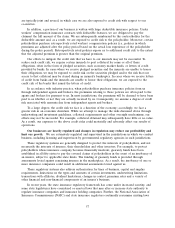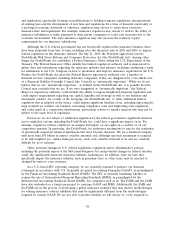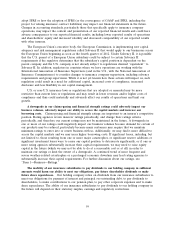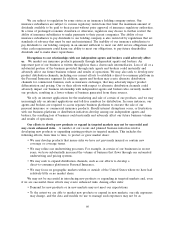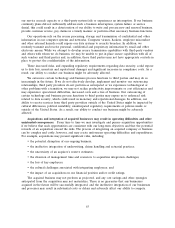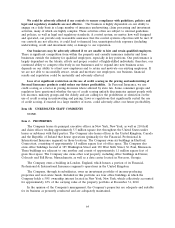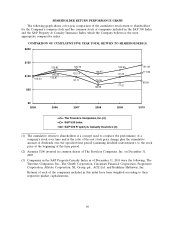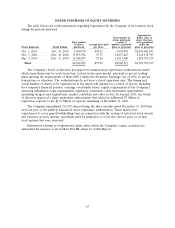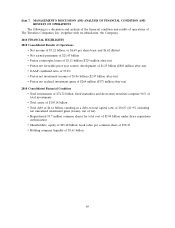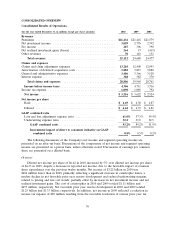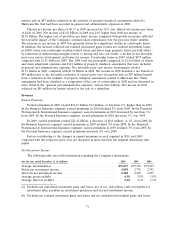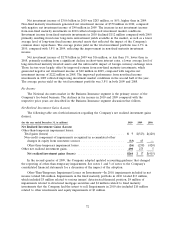Travelers 2010 Annual Report Download - page 76
Download and view the complete annual report
Please find page 76 of the 2010 Travelers annual report below. You can navigate through the pages in the report by either clicking on the pages listed below, or by using the keyword search tool below to find specific information within the annual report.We could be adversely affected if our controls to ensure compliance with guidelines, policies and
legal and regulatory standards are not effective. Our business is highly dependent on our ability to
engage on a daily basis in a large number of insurance underwriting, claim processing and investment
activities, many of which are highly complex. These activities often are subject to internal guidelines
and policies, as well as legal and regulatory standards. A control system, no matter how well designed
and operated, can provide only reasonable assurance that the control system’s objectives will be met. If
our controls are not effective, it could lead to financial loss, unanticipated risk exposure (including
underwriting, credit and investment risk) or damage to our reputation.
Our businesses may be adversely affected if we are unable to hire and retain qualified employees.
There is significant competition from within the property and casualty insurance industry and from
businesses outside the industry for qualified employees, especially in key positions. Our performance is
largely dependent on the talents, efforts and proper conduct of highly-skilled individuals; therefore, our
continued ability to compete effectively in our businesses and to expand into new business areas
depends on our ability to attract new employees and to retain and motivate our existing employees. If
we are not able to successfully attract, retain and motivate our employees, our business, financial
results and reputation could be materially and adversely affected.
Loss of or significant restriction on the use of credit scoring in the pricing and underwriting of
Personal Insurance products could reduce our future profitability. In Personal Insurance, we use
credit scoring as a factor in pricing decisions where allowed by state law. Some consumer groups and
regulators have questioned whether the use of credit scoring unfairly discriminates against people with
low incomes, minority groups and the elderly and are calling for the prohibition or restriction on the
use of credit scoring in underwriting and pricing. Laws or regulations that significantly curtail the use
of credit scoring, if enacted in a large number of states, could adversely affect our future profitability.
Item 1B. UNRESOLVED STAFF COMMENTS
NONE.
Item 2. PROPERTIES
The Company leases its principal executive offices in New York, New York, as well as 210 field
and claim offices totaling approximately 5.5 million square feet throughout the United States under
leases or subleases with third parties. The Company also leases offices in the United Kingdom, Canada
and the Republic of Ireland that house operations (primarily for the Financial, Professional &
International Insurance segment) in those locations. The Company owns six buildings in Hartford,
Connecticut, consisting of approximately 1.8 million square feet of office space. The Company also
owns office buildings located at 385 Washington Street and 130 West Sixth Street, St. Paul, Minnesota.
These buildings are adjacent to one another and consist of approximately 1.1 million square feet of
gross floor space. The Company also owns other real property, including office buildings in Denver,
Colorado and Fall River, Massachusetts, as well as a data center located in Norcross, Georgia.
The Company owns a building in London, England, which houses a portion of its Financial,
Professional & International Insurance segment’s operations in the United Kingdom.
The Company, through its subsidiaries, owns an investment portfolio of income-producing
properties and real estate funds. Included in this portfolio are four office buildings in which the
Company holds a 50% ownership interest located in New York, New York, which collectively accounted
for approximately 12% of the carrying value of the property portfolio at December 31, 2010.
In the opinion of the Company’s management, the Company’s properties are adequate and suitable
for its business as presently conducted and are adequately maintained.
64



